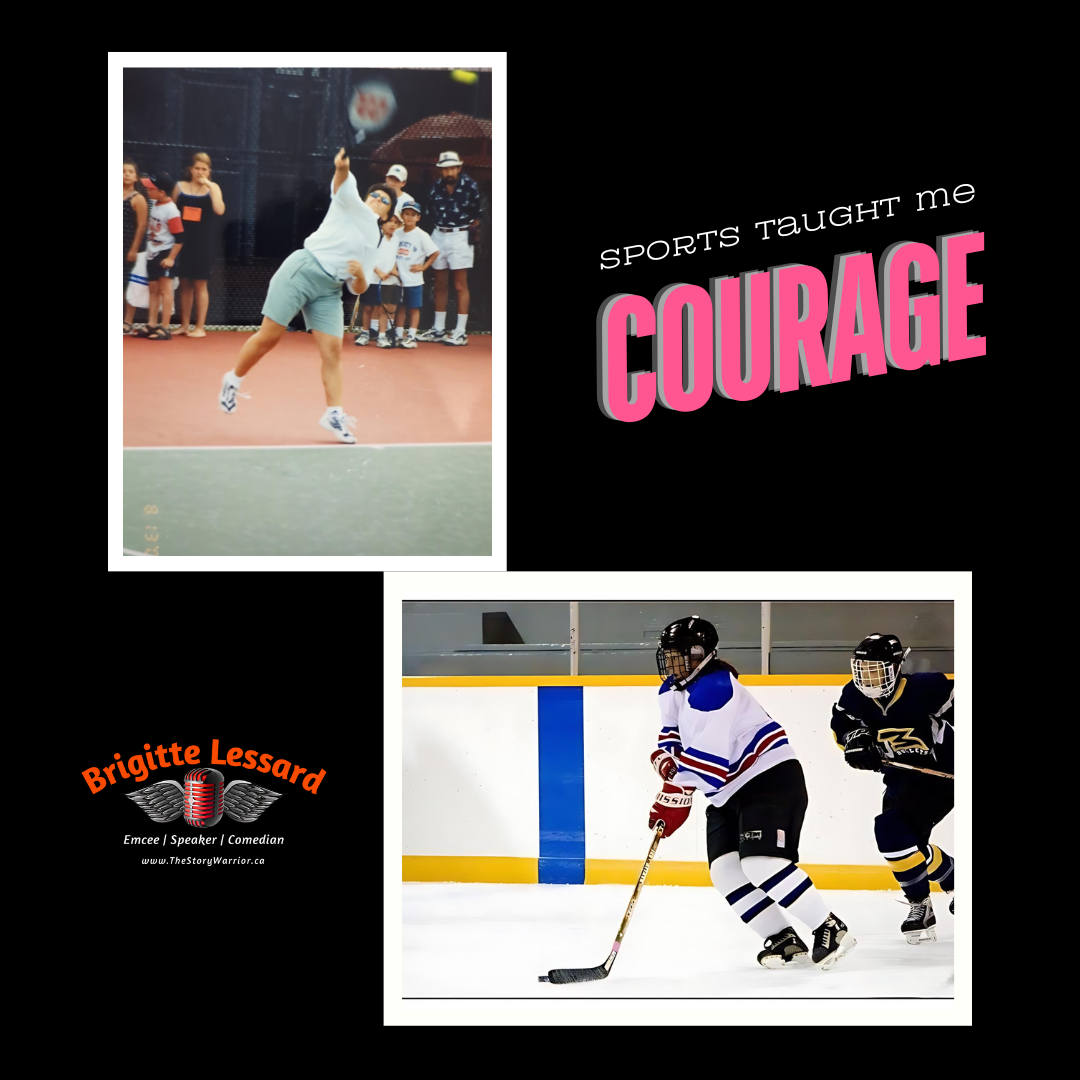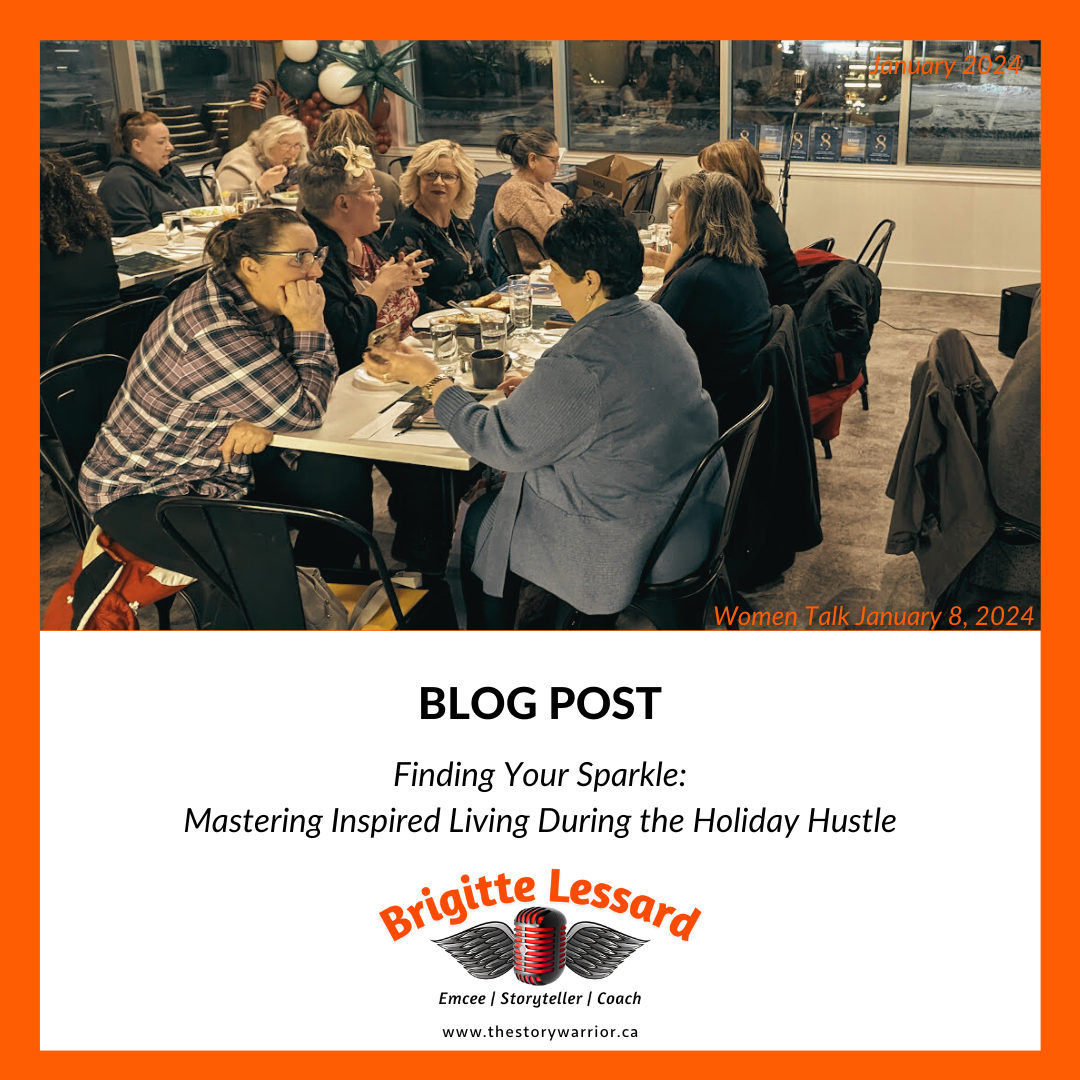
What an amazing Olympics Canada is having! 🌟 I’m sure you, just like me, are glued to the screen, cheering for our Olympians, and maybe even feeling a tad out of breath just watching their sheer dedication. Partnering with Olympian Danielle Goyette when I kicked off this company gave me a front-row seat to what it takes to be an Olympian—and let me tell you, just thinking about it has me reaching for a nap! Now, here’s a stat that might make you want to sit down: by their teenage years, 62% of Canadian girls have dropped out of sports. Yup, that’s a whopping majority! As a woman who defied the odds by picking up sports in my late teens, I’ve got to say, it's a real bummer. I played competitive hockey and tennis for years—long enough to learn about leadership, teamwork, and how to lose with dignity (and maybe just a few tears). These are lessons that have been game-changers, both in business and in life. But the real MVP? Courage. The courage to step onto the ice, the court, or the stage (hey, I’m a comedian after all), knowing full well that things might not go my way—but doing it anyway. I lost more than I won, and yes, I cried, but I always got back up, ready for the next round. Because at the end of the day, it’s not about the medals; it’s about the journey, the stories, and the laughs we collect along the way. So, to all the women Olympians out there: go hard, then go home, and know that we are already bursting with pride for you, no matter the outcome. You’ve got our full support—and yes, that includes the perfect sports bra from SPORTSBRAS.CA! And to all my fellow Canadian women, whether you’re a 32A or a 44H, whether you’re walking, skating, or bouncing a ball, I’m here to make sure you’ve got the support you need—literally. Because let’s face it, we all need a little lift sometimes, and I’m not just talking about sports bras! Cheers to 25 years of supporting Canadian women and making sure you’ve got less bounce for your buck! 😄💖

As the fearless leader of SportsBras.ca , , and the proud champion of single moms everywhere, let's dive into the wild world of falling down and getting back up again! Life's journey is like a rollercoaster—full of unexpected twists, turns, and the occasional face-plant. Trust me, I've hosted events where the attendance could fit in a phone booth, lost tennis matches I could've won blindfolded, and turned my kitchen into a recipe demolition zone more times than I can count. And let's not forget the thrill of rebuilding my life at both 17 and 57 years young! But here's the secret sauce to bouncing back: resilience, baby! It's about dusting off those knees, summoning your inner warrior, and taking life's curveballs head-on. Sure, progress might be slower than a snail on a coffee break, but every tiny step forward is a victory worth celebrating! And guess what? You're not in this alone. Cue the drumroll for the tribe—the fabulous souls who lift you higher, cheer you louder, and remind you that even on your worst day, you're still a rockstar! So, let's raise a glass to face-planting with style, bouncing back like a champ, and turning our setbacks into epic stories that inspire, entertain, and maybe even make IKEA furniture assembly seem like a piece of cake! Remember, falling down is just part of the adventure. But getting back up? Well, that's where the magic happens! So, chin up, my fellow warriors, and let's conquer this crazy journey called life together, one epic comeback at a time! And hey, don't forget to share those inspiring tales—whether it's in a book, on stage, or over a cup of coffee with your bestie. Because when we share our stories, we not only connect on a deeper level but also sprinkle a little magic into someone else's journey!

The Healing Power of Storytelling Stories have always held a special place in our lives. From the tales our grandparents shared during bedtime to the novels we immerse ourselves in, stories have the remarkable ability to transport us to different worlds, evoke emotions, and ignite our imaginations. Yet, there's a deeper and more profound aspect to storytelling that often goes unnoticed – its healing powers. The Cathartic Release of Emotions Have you ever noticed how telling someone about your day, sharing your struggles, or recounting your triumphs can make you feel lighter, as if a weight has been lifted from your shoulders? This is the essence of storytelling. When we share our experiences, we not only convey information but also release the emotions that come with those experiences. It's a cathartic process, akin to cleansing the soul. Fostering Connection and Empathy Storytelling is not just about sharing; it's also about listening. When we listen to someone's story, we open our hearts and minds to their experiences, even if they are vastly different from our own. This act of empathetic listening fosters a sense of connection and understanding. It reminds us that, at our core, we are all human beings with our unique journeys and challenges. Finding Strength in Vulnerability Sharing our stories can be an act of vulnerability, but it is within this vulnerability that we often find our greatest strength. When we open up about our struggles and triumphs, we create a safe space for others to do the same. We become beacons of hope and resilience, inspiring those around us to confront their own challenges with courage. Discovering Self and Identity Storytelling is not only about sharing with others; it's also a means of self-discovery. As we narrate our experiences, we gain insights into our own thoughts, feelings, and beliefs. We reflect on our past actions and future aspirations, and in doing so, we often uncover our true selves. Healing Through Creativity Storytelling comes in many forms – it could be through writing, speaking, art, or even dance. Engaging in creative storytelling allows us to explore our emotions and experiences in unique ways. It's a form of self-expression that can be incredibly therapeutic. Storytelling is a powerful tool for healing. It allows us to release pent-up emotions, connect with others on a profound level, find strength in vulnerability, and discover our true selves. So, whether you're sharing your story with a friend, writing in a journal, or engaging in any form of creative expression, remember that your story has the potential to heal not only you but also those who have the privilege of hearing it. Embrace the healing power of storytelling, and let it be a guiding light on your journey of self-discovery and growth. Women Talk's Mystical Power I am firmly convinced that Women Talk possesses a certain mystical power, a profound influence that has worked wonders in the healing journeys of countless women. Through the connections, conversations, and shared experiences within the Women Talk community, I've witnessed an extraordinary transformation, where women have found solace, support, and empowerment to overcome challenges and embark on paths of personal growth and healing. It's a remarkable testament to the strength of this community and the potent, transformative impact it has on the lives of the women it touches.

The Healing Power of Storytelling Stories have always held a special place in our lives. From the tales our grandparents shared during bedtime to the novels we immerse ourselves in, stories have the remarkable ability to transport us to different worlds, evoke emotions, and ignite our imaginations. Yet, there's a deeper and more profound aspect to storytelling that often goes unnoticed – its healing powers. The Cathartic Release of Emotions Have you ever noticed how telling someone about your day, sharing your struggles, or recounting your triumphs can make you feel lighter, as if a weight has been lifted from your shoulders? This is the essence of storytelling. When we share our experiences, we not only convey information but also release the emotions that come with those experiences. It's a cathartic process, akin to cleansing the soul. Fostering Connection and Empathy Storytelling is not just about sharing; it's also about listening. When we listen to someone's story, we open our hearts and minds to their experiences, even if they are vastly different from our own. This act of empathetic listening fosters a sense of connection and understanding. It reminds us that, at our core, we are all human beings with our unique journeys and challenges. Finding Strength in Vulnerability Sharing our stories can be an act of vulnerability, but it is within this vulnerability that we often find our greatest strength. When we open up about our struggles and triumphs, we create a safe space for others to do the same. We become beacons of hope and resilience, inspiring those around us to confront their own challenges with courage. Discovering Self and Identity Storytelling is not only about sharing with others; it's also a means of self-discovery. As we narrate our experiences, we gain insights into our own thoughts, feelings, and beliefs. We reflect on our past actions and future aspirations, and in doing so, we often uncover our true selves. Healing Through Creativity Storytelling comes in many forms – it could be through writing, speaking, art, or even dance. Engaging in creative storytelling allows us to explore our emotions and experiences in unique ways. It's a form of self-expression that can be incredibly therapeutic. Storytelling is a powerful tool for healing. It allows us to release pent-up emotions, connect with others on a profound level, find strength in vulnerability, and discover our true selves. So, whether you're sharing your story with a friend, writing in a journal, or engaging in any form of creative expression, remember that your story has the potential to heal not only you but also those who have the privilege of hearing it. Embrace the healing power of storytelling, and let it be a guiding light on your journey of self-discovery and growth. Women Talk's Mystical Power I am firmly convinced that Women Talk possesses a certain mystical power, a profound influence that has worked wonders in the healing journeys of countless women. Through the connections, conversations, and shared experiences within the Women Talk community, I've witnessed an extraordinary transformation, where women have found solace, support, and empowerment to overcome challenges and embark on paths of personal growth and healing. It's a remarkable testament to the strength of this community and the potent, transformative impact it has on the lives of the women it touches.

Variety and pace are essential elements of effective storytelling that can help maintain your audience's engagement and prevent your narrative from becoming monotonous or predictable. Here's a more detailed explanation of this concept: CHANGE IN PACE: Altering the pace of your storytelling involves adjusting the speed at which you deliver your narrative. Sometimes, you might want to slow down to emphasize key moments or details that require more attention. This allows your audience to savor and absorb the information. Conversely, you can speed up the pace when describing action-packed sequences or when building suspense. Rapid pacing can keep your audience on the edge of their seats, eager to know what happens next. TONE VARIATION: The tone of your storytelling refers to the emotional quality or mood you convey through your words and delivery. Different parts of your story may require different tones. For example, you might use a cheerful and upbeat tone when recounting a happy moment or a somber and reflective tone when discussing a sad or serious topic. Varying your tone helps you effectively convey the emotions and nuances of the story. STYLE ADAPTATION: Style refers to the way you narrate your story, including the choice of language, narrative techniques, and storytelling devices. Adapt your style to suit the content and context of your narrative. For instance, you might use a first-person perspective and colloquial language for a personal anecdote, whereas a third-person omniscient perspective with formal language might be more suitable for a historical account. Adapting your style enhances the storytelling experience and keeps it fresh for the audience. VISUAL AND AUDITORY ELEMENTS: Incorporate visual and auditory elements when appropriate. This can include using props, visual aids, or multimedia presentations to enhance certain parts of your story. These elements can add variety to your storytelling and engage multiple senses, making the experience more immersive. Dialogue Variation: If your story involves dialogue between characters, vary the way you present it. Use different voices or tones for each character to make their personalities distinct. Dialogue can inject energy into your narrative and provide a break from continuous narration. Use of Pause and Silence: Don't underestimate the power of pauses and silence. Strategic pauses can create anticipation and suspense, allowing your audience to absorb what you've said and anticipate what comes next. Silence can also emphasize certain points or create a dramatic effect. SURPRISE AND SUBVERSION: Occasionally, surprise your audience by subverting their expectations. Introduce an unexpected twist or viewpoint to keep them engaged and eager to see where the story goes. This can add an element of excitement and unpredictability to your narrative. In summary, varying your storytelling techniques, including pace, tone, style, and the use of visual and auditory elements, keeps your storytelling dynamic and captivating. By adapting these elements to match the content and context of your story, you can maintain your audience's interest and create a more memorable and enjoyable storytelling experience.

The Perfect Trifecta of Storytelling: Vulnerability, Drama, and Transformation" is a powerful concept that highlights key elements to make your storytelling more impactful and captivating. Let's elaborate on each component: Vulnerability: Vulnerability is the act of exposing your true self, including your emotions, fears, and insecurities. When you share your story with vulnerability, you connect with your audience deeply and authentically. Your willingness to be open and honest about your experiences makes your storytelling relatable, and relatable storytelling is often the most powerful. It allows your audience to see themselves in your story and feel a sense of empathy, creating a genuine connection. When you peel away the layers and reveal your raw emotions, you invite your audience to do the same, creating a space for shared understanding and catharsis. Drama: Drama adds excitement, tension, and suspense to your storytelling. By highlighting the challenges, obstacles, or dilemmas you faced during your journey, you create a narrative that keeps your audience engaged and eager to discover what happens next. Drama can take many forms, from external conflicts to internal struggles, but it's the element that propels your story forward. It's where you create anticipation and curiosity, making your audience emotionally invested in the outcome. Drama adds depth and complexity to your narrative, making it more compelling and memorable. Transformation: Transformation is the arc of personal growth and change that occurs throughout your story. Sharing how you evolved as a result of your experiences adds a powerful dimension to your narrative. It allows your audience to witness your journey of self-discovery, learning, and adaptation. Transformation not only makes your story more relatable but also inspires and motivates your audience. It shows that challenges and hardships can lead to personal growth and positive change, offering hope and a sense of possibility. Sharing your transformation also brings a sense of closure to your story, leaving your audience with a satisfying conclusion. By incorporating vulnerability, drama, and transformation into your storytelling, you create an emotionally resonant and thought-provoking narrative. These elements draw your audience into your world, spark their imagination, and make them feel a part of your journey. The combination of vulnerability, drama, and transformation weaves a spell that leaves your readers or listeners enchanted and craving more. It's the essence of storytelling that touches hearts and minds, leaving a lasting impact on those who experience your story.

" The single biggest barrier to not telling your stories isn't stage fright. It's assuming you don't have a story in the first place. " Each time you say “I don’t have any stories,” you are lying to yourself! The truth is, your stories are there, it’s just that you can’t see them. We all have stories to tell. Ideas are passing by all the time, but you have to keep up the right frequencies to perceive them. Learning to share your stories will change your life! It will help grow your business, your causes and credibility. Not to mention, it will help and inspire people around you. Speakers - Bloggers - Writers - Podcasters - Business Owners, do you need more stories? Attend my workshop to discover the stories you can use to grow your business, your social influence and your communication skills. "I am so convinced you will discover multiple stories to share that if you don't...I will give you your money back! "


